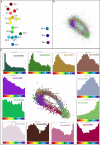The Transcriptional Network That Controls Growth Arrest and Macrophage Differentiation in the Human Myeloid Leukemia Cell Line THP-1
- PMID: 32719792
- PMCID: PMC7347797
- DOI: 10.3389/fcell.2020.00498
The Transcriptional Network That Controls Growth Arrest and Macrophage Differentiation in the Human Myeloid Leukemia Cell Line THP-1
Abstract
The response of the human acute myeloid leukemia cell line THP-1 to phorbol esters has been widely studied to test candidate leukemia therapies and as a model of cell cycle arrest and monocyte-macrophage differentiation. Here we have employed Cap Analysis of Gene Expression (CAGE) to analyze a dense time course of transcriptional regulation in THP-1 cells treated with phorbol myristate acetate (PMA) over 96 h. PMA treatment greatly reduced the numbers of cells entering S phase and also blocked cells exiting G2/M. The PMA-treated cells became adherent and expression of mature macrophage-specific genes increased progressively over the duration of the time course. Within 1-2 h PMA induced known targets of tumor protein p53 (TP53), notably CDKN1A, followed by gradual down-regulation of cell-cycle associated genes. Also within the first 2 h, PMA induced immediate early genes including transcription factor genes encoding proteins implicated in macrophage differentiation (EGR2, JUN, MAFB) and down-regulated genes for transcription factors involved in immature myeloid cell proliferation (MYB, IRF8, GFI1). The dense time course revealed that the response to PMA was not linear and progressive. Rather, network-based clustering of the time course data highlighted a sequential cascade of transient up- and down-regulated expression of genes encoding feedback regulators, as well as transcription factors associated with macrophage differentiation and their inferred target genes. CAGE also identified known and candidate novel enhancers expressed in THP-1 cells and many novel inducible genes that currently lack functional annotation and/or had no previously known function in macrophages. The time course is available on the ZENBU platform allowing comparison to FANTOM4 and FANTOM5 data.
Keywords: THP-1 cells; cell cycle; differentiation; macrophage; monocyte; p53; transcriptome.
Copyright © 2020 Gažová, Lefevre, Bush, Clohisey, Arner, de Hoon, Severin, van Duin, Andersson, Lengeling, Hume and Summers.
Figures







Similar articles
-
Comparison of retinoic acid and phorbol myristate acetate as inducers of monocytic differentiation.Int J Cancer. 1994 Apr 1;57(1):98-103. doi: 10.1002/ijc.2910570118. Int J Cancer. 1994. PMID: 7512079
-
Changes in IgG Fc receptor expression induced by phorbol 12-myristate 13-acetate treatment of THP-1 monocytic leukemia cells.Leuk Res. 1992;16(3):317-27. doi: 10.1016/0145-2126(92)90070-n. Leuk Res. 1992. PMID: 1532844
-
Signal transduction of phorbol 12-myristate 13-acetate (PMA)-induced growth inhibition of human monocytic leukemia THP-1 cells is reactive oxygen dependent.Leuk Res. 2005 Aug;29(8):863-79. doi: 10.1016/j.leukres.2004.12.011. Epub 2005 Feb 24. Leuk Res. 2005. PMID: 15978937
-
Differentiation primary response genes and proto-oncogenes as positive and negative regulators of terminal hematopoietic cell differentiation.Stem Cells. 1994 Jul;12(4):352-69. doi: 10.1002/stem.5530120402. Stem Cells. 1994. PMID: 7951003 Review.
-
The human leukemia cell line, THP-1: a multifacetted model for the study of monocyte-macrophage differentiation.Experientia. 1991 Jan 15;47(1):22-31. doi: 10.1007/BF02041244. Experientia. 1991. PMID: 1999239 Review.
Cited by
-
HCV Core Protein Induces Chemokine CCL2 and CXCL10 Expression Through NF-κB Signaling Pathway in Macrophages.Front Immunol. 2021 Aug 31;12:654998. doi: 10.3389/fimmu.2021.654998. eCollection 2021. Front Immunol. 2021. PMID: 34531848 Free PMC article.
-
xCT/SLC7A11 antiporter function inhibits HIV-1 infection.Virology. 2021 Apr;556:149-160. doi: 10.1016/j.virol.2021.01.008. Epub 2021 Jan 20. Virology. 2021. PMID: 33631414 Free PMC article.
-
Size-tuneable and immunocompatible polymer nanocarriers for drug delivery in pancreatic cancer.Nanoscale. 2022 May 5;14(17):6656-6669. doi: 10.1039/d2nr00864e. Nanoscale. 2022. PMID: 35438701 Free PMC article.
-
Construction of a tunable promoter library to optimize gene expression in Methylomonas sp. DH-1, a methanotroph, and its application to cadaverine production.Biotechnol Biofuels. 2021 Dec 4;14(1):228. doi: 10.1186/s13068-021-02077-8. Biotechnol Biofuels. 2021. PMID: 34863247 Free PMC article.
-
Elf1 Deficiency Impairs Macrophage Development in Zebrafish Model Organism.Int J Mol Sci. 2025 Mar 12;26(6):2537. doi: 10.3390/ijms26062537. Int J Mol Sci. 2025. PMID: 40141178 Free PMC article.
References
-
- Baillie J. K., Arner E., Daub C., De Hoon M., Itoh M., Kawaji H., et al. (2017). Analysis of the human monocyte-derived macrophage transcriptome and response to lipopolysaccharide provides new insights into genetic aetiology of inflammatory bowel disease. PLoS Genet. 13:e1006641. 10.1371/journal.pgen.1006641 - DOI - PMC - PubMed
LinkOut - more resources
Full Text Sources
Other Literature Sources
Research Materials
Miscellaneous

